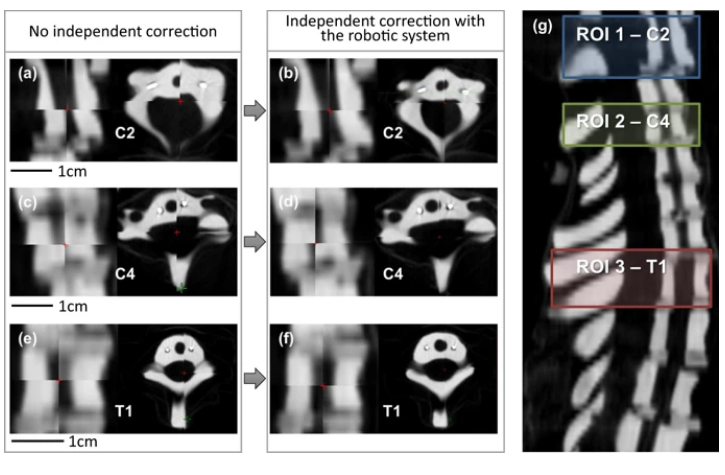

In ‘Radiotherapy-Compatible Robotic System for Multi-Landmark Positioning in Head and Neck Cancer Treatments,’ authors Mark Ostyn, Siqiu Wang, Yun-Soung Kim, Siyong Kim, and Woon-Hong Yeo discuss the challenges of dealing with spine flexibility in radiation therapy and explore the accompaniment of robotics to help improve positioning.
To prevent neck flexibility resulting in problems during therapy, medical professionals often employ passive immobilization masks to prevent motion and encourage successful positioning. The authors also point out, however, that studies over time have shown that such masks still have a margin of error of 3–5 mm between distant landmarks along the spine of the neck.
“Recent reports show that an accurate positioning in head and neck therapy can be achieved by independent positioning of the head from the rest of the body,” state the researchers. “However, these mechanical systems have not yet been introduced into regular clinical practice.”
No other systems have been radiotherapy-compatible so far, leaving the authors to take matters into their own hands and develop a robotic system which is suitable for radiotherapy.
“In this new system, all radiotherapy-incompatible components are arranged far outside of the radiation field, placed 40 cm inferior to radiation isocenter with a novel, plastic gearbox that reduces linear accelerator gantry clearance issues,” stated the researchers. “As a result of transitioning from direct to indirect power transmission from stepper motors to end effectors, a mostly-plastic secondary position feedback is introduced to aid in navigation.”
The system is validated with attenuation measurement, as well as radiographic imaging. In designing the robotic system, the researchers were determined to make structures as small as possible, but still able to offer the necessary range of motion. The researchers put the metal motors in between the patient and in this case for the study, the couch top.

They 3D printed almost all the components, to include:
- Gear box
- End effector assembly
- Enclosure
- Mounting frame
Two 3D printers are capable of making such parts in a superior manner, according to the researchers: the Formlabs Form 2 printer and the Objet Eden 260VS. Materials used included ABS, as well as PLA when using other 3D printers.
“In addition, the top plate of the head/neck controller that needs an extra high strength is fabricated by machining a carbon-fiber-reinforced plastic, which holds a patient’s head,” stated the researchers.
The researchers included 15 trails, with a variety of displacements, from 1.1 to 5.2mm.
“This presented system is capable of positioning a patient’s head with submillimeter accuracy in clinically acceptable spatial constraints. Calculated attenuation of materials in the system have lower HU values than a reference material (bone tissue), which is validated by a set of radiographic images with no visible artifacts,” concluded the researchers.
“The result of positioning accuracy with a skeletal phantom determines the device’s accuracy as 0.7 ± 0.3 mm. In addition, CBCT imaging and post correction study validates the system’s functionality for aligning individual regions when the head and body are individually positioned. Future work will focus on the radiotherapy application for patients with head and neck cancer.”
3D printing and robotics go hand in hand quite literally in many instances, from ultra-programmable systems to sensor technology, and even manufacturing for industries such as furniture design. What do you think of this news? Let us know your thoughts; join the discussion of this and other 3D printing topics at 3DPrintBoard.com.
[Source / Images: ‘Radiotherapy-Compatible Robotic System for Multi-Landmark Positioning in Head and Neck Cancer Treatments’]
If you're looking to get architectural 3D animation in the USA, our service provides an exceptional way to bring your architectural concepts to life through dynamic, immersive visuals. Through our platform, you can easily request high-quality 3D animations that showcase your designs in motion, offering a detailed view of your project from multiple angles and perspectives. Whether it's for a real estate development, a commercial building, or an urban planning project, our expert team ensures that every detail is captured in a visually compelling animation.
Through our website, you can seamlessly get architectural 3D animation tailored to your project’s specific needs. With our help, you can offer potential clients or investors an engaging experience that goes beyond static images. By integrating CGI animations with real-world settings, lighting, and textures, our team creates a lifelike experience that allows your audience to interact with your project as though it were already built. This service is perfect for presenting complex designs in a clear, visually attractive way that stands out in the competitive architectural market.




